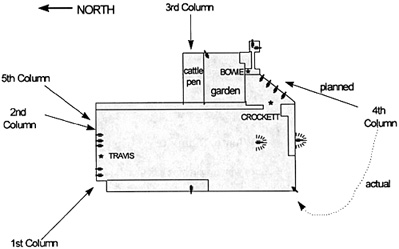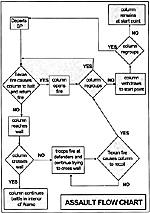Greetings fellow solo gamers. Let me tell you up front that this is a two part article. I have only begun to play test some of the detailed tables to see if they yielded historically supportable results and I am not willing to give you folks something that is half baked. So, for your reading pleasure, I present "How to solo the Alamo!" part 1.
My purpose here is to offer a methodology that should be applicable in most cases to come up with a set of scenario specific solo rules. I am using the siege of the Alamo as a test bed. The large steps, as I see them, are:
- research the scenario
- identify variables you want to simulate
- devise the rules
Researching the Alamo should be easy and fun. We have a fairly good understanding of what went on in the Alamo (or what we think happened or what we would like to have happened). There are any number of historical and fictitious accounts in the form of books, articles, and movies. For this article, I used Albert A. Nofi's The Alamo and the Texas War for Independence (Combined Books: Conshohocken, PA, 1992). I am going to outline below only a few salient features that will be useful in devising our rules.
Santa Anna showed up in San Antonio on 23 February 1836, well earlier than expected, and caught Colonel William Barret Travis and his command ill-prepared. The task of turning the abandoned mission into a fortress was only half completed and the Texans had not secured enough food to feed the garrison for more than a couple weeks. Travis ordered his troops into the old mission and sent messengers to secure aid. Santa Anna, with about 1500 soldiers and eight guns, set up a loose siege and waited for his 12-pound guns and the remainder of his army.
On 24 February, Santa Anna opened two batteries of four guns each (six light field pieces and two 7-inch howitzers). Over the next several days there was some skirmishing (which you may choose to game), and sporadic artillery fire (which weakened the adobe walls of the Alamo). On 4 March, another 1200 Mexicans arrived bringing with them another howitzer. Santa Anna decided to attack at dawn on 6 March even though his 12 pounders were not expected to arrive before then.
The Mexican assault would be composed of five infantry columns. Recruits were not included, just the experienced troops. The available cavalry surrounded the Alamo in a loose ring to stop anyone from escaping. The five columns are described below.
1st Column (Brigadier General Cos)
400 men, 10 ladders
Aldama Battalion - 300 (minus grenadier company)
San Luis Potosi Battalion - 100 (3 line companies)
2nd Column (Colonel Duque, commander of the Toluca Battalion)
380 men, 10 ladders
1st Toluca Bn - 280 (minus grenadier company)
San Luis Potosi Battalion - 100 (3 line companies)
3rd Column (Colonel Romero of the Matamoros Battalion)
400 men
Jimenez Battalion - 200 (minus light and grenadier companies)
Matamoros Battalion - 200 (minus light and grenadier companies)
4th Column (Colonel Morales of the San Luis Potosi Battalion)
105 men, 2 ladders
light companies from the Matamoros, Jimenez, and San Luis Potosi battalions
5th Column - Reserve (Colonel Amat of the elite Zapadores battalion)
385 men
Zapadores Battalion - 185
grenadier companies from the Matamoros, Jimenez, Aldama, 1st Toluca, and San Luis
Potosi battalions - 200
Additionally, there was a body of 380 cavalry consisting of:
Dolores Cavalry Regiment - 285
Presidiales del Rio Grande - 55
Coabuila Cavalry Regiment - 30
Vera Cruz Cavalry Regiment - 10

The assault began at dawn on 6 March as buglers sounded the advance and the four columns (minus the reserve of course) began to cross the 300 yards of open ground between their advance positions and the Alamo. The Texan sentries immediately sounded the alarm as the remainder of the defenders sprang to the walls and opened a hot fire. Cannon blasts and rifle and musket fire ripped into the attacking columns causing them to recoil momentarily. But the Mexican officers prevailed and got their men moving forward again. Travis was killed early by a musket ball in his forehead.
Soon, one column after another (except for the 4th column which was turned back by Crockett's riflemen) made it to the relative safety of the walls. The Texans could not lean over the walls without exposing themselves to the milling masses below. The attackers tried with little success to climb up the flimsy ladders. At this point, Santa Anna intervened. He committed the reserve column while ordering buglers to play the "Deguello" which signaled the attackers to grant no quarter. With three columns intermingled at the northern wall, some of the men found that they could climb up the wall face where it had been fractured by artillery fire and imperfect repairs. Up and over they went, clearing the walls of defenders. The Texans spun around the guns in the plaza and opened fire as the Mexicans poured over the north wall in increasing numbers. The light infantry, turned away by the Tennesseans, regrouped and assaulted the southwest corner of the enclosure. After a hard fight, they succeeded in capturing the gun there and turning it on the defenders.
As hundreds of Santa Anna's troops breached the walls, the Texans fell back into the buildings and there sold their lives dearly in numerous hand-to-hand fights. Crockett's men, successful in their defense of the low wooden palisade, were now taken in the rear and slowly cut down. Where they could not root out the defenders from their well prepared rooms, the Mexicans blasted them out with their own cannon. A few Texans fled the Alamo only to be ridden down by the cavalry Santa Anna had posted in a ring around the fortress. The Chapel itself held the last of the defenders, including the sick Jim Bowie, who sold their lives dearly. After two hours it was over. Santa Anna ordered a handful of captives to be bayoneted in his presence. One hundred eighty-nine brave Texans were slain. Perhaps 70 equally brave Mexicans died in the assault and as many as 300 died later from their wounds. The smug tyrant Santa Anna continued his march northward to San Jacinto where he was utterly defeated at by a smaller Texan force under the redoubtable Sam Houston.
Having enjoyed the thrill that comes with researching a battle, the solo gamer is now faced with selecting those variables that he wishes to simulate. A wargame designer might tell you that this is a difficult step. If you try to simulate every nuance of a nifty battle such as idiosyncrasies of leaders or detailed variation of weapons performance, the product is likely to be a complex set of rules in which the various pieces are out of balance. Exercising care at this point, select what appears to you to be those key issues that give this particular battle its distinctive flavor. I decided to use the following list as a strawman to begin the effort:
.
- effects of preliminary bombardment and Texan counter battery fire.
- number of assault columns and their composition
- quality of troops in each column
- effects of leadership on both forces
- point of attack of assaulting columns
- effects of Texan fire on column's forward movement
- effects of Mexican musket fire
- effect on Texan defense if a Mexican column is turned back
To assist me at this point in finding relationships among the factors above, I put together a flow chart which traced the story of a Mexican column from the time it departed the start point to the time it crossed the Alamo's walls. Here's what I came up with.
I figured that the Mexican assault column departs its start point and begins moving toward that portion of the wall designated by its commander, who is leading from the front. However, accurate cannon and small arms fire from the Alamo might be of sufficient volume or wound the commander and thus cause the column to halt. If so, then the column would halt (despite the exhortations of the officers) and open a sporadic fire. With the troops milling around and the formation losing order, the officers might get it to regroup and move forward. However, the longer it takes to re-establish order or perhaps the more casualties suffered, the less chance that the officers will be successful. If they can not get the column moving forward, then soon the troops would fall back to their start point. Again, the officers attempt to rally the troops, reform them, and get them moving once again. Santa Anna himself might show up and bring his great influence to bear. This process might take some time and in the end, the Mexican column might not ever regain its forward momentum.
If the column makes it to the relative safety of the wall, then the troops can attempt to cross. They use ladders or climb up the rubbled sections caused by artillery fire. Of course, the hard part is the hand-to-hand fighting atop the walls. As long as the Mexicans have to fight atop the walls, they will be crossing slowly. If they clear the walls of defenders, then they can cross in a torrent. If the Mexicans can not get a party across, then it is possible that the defensive fire and fierce melee may cause those soldiers at the base of the wall to fall back from the wall to seek safety. Again, the officers will try to rally them and either get them going forward or lose control and watch as their soldiers flee back to the start point.
Of course, the Mexicans aren't the only folks involved. As the Texan player, I want to cause the columns to recoil. My best chance of this is before the assault column reaches the wall. Thus I want to shift fires to the most dangerous threat of the moment and if a column reaches the wall, to position what forces I have to keep them from crossing. If a column succeeds in crossing, I might want to withdraw some troops to the safety of the interior buildings and try to destroy the Mexicans now in the plaza by fire rather than by hand-to-hand fighting. And the big decision I have to make is when to re-position or pull back troops who have been successful defending their section of wall to assist in stopping a Mexican column now rampaging in the central plaza. While there is no evidence that Colonel Travis did so, I might want to maintain a slender reserve in the interior to respond to the threat of Mexican columns about to come over the top of the walls.
The above discussion presents the dynamics of what it is I want to address in my rules. As is the case in solo gaming, the rules covering the Mexicans are going to have to be automated, to cause their behavior to be reactive to events. I do not want to make decisions for them. For example, they will recoil or regroup based on probability of response to various combinations of casualties over time, leadership, troop quality and other pertinent factors. The problem arises in developing a balanced set of rules that yield credible results. So, if you will allow, I will now retire to devise a set of rules to present to you next issue. Until then, Good Soloing!
Back to MWAN #90 Table of Contents
Back to MWAN List of Issues
Back to MagWeb Magazine List
© Copyright 1997 Hal Thinglum
This article appears in MagWeb (Magazine Web) on the Internet World Wide Web.
Other military history articles and gaming articles are available at http://www.magweb.com
